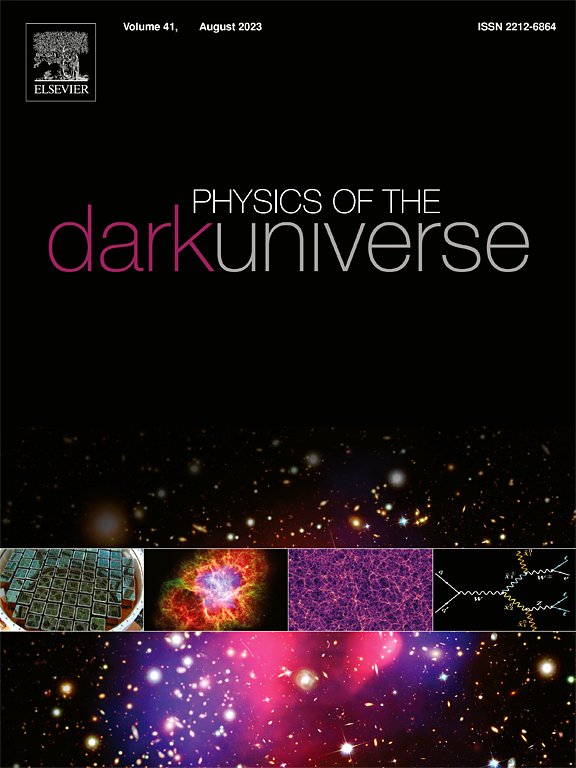幻影增强的kkb - ramond引力中的违反洛伦兹的ModMax黑洞:热力学和拓扑电荷
IF 6.4
2区 物理与天体物理
Q1 ASTRONOMY & ASTROPHYSICS
引用次数: 0
摘要
我们在四维爱因斯坦引力的框架内推导出精确的静态球对称黑洞(BH)解,并结合ModMax非线性电动力学和Kalb-Ramond两种形式。这种耦合是由一个离散符号参数控制的,表示为ζ=±1。在“普通”分支(ζ=+1)中,度规同时具有柯西视界和事件视界,而电磁应力-能则符合所有经典能量条件。相反,“幽灵”分支(ζ=−1)只容纳单一视界,同时违反弱,零和强条件,这反映了真正的鬼-物质行为。ζ=+1的热力学行为导致热容的多重发散,并在AdS Gibbs自由能中呈现出独特的燕尾模式,表明一阶相变包括小相,中相和大相。相反,对于ζ= - 1,只观察到一个散度,伴随着一个光滑的吉布斯曲线,没有范德华式振荡行为,这排除了真正共存的可能性。在AdS中使用Duan的φ-映射进行拓扑分析,通过检查分支的圈数进一步区分分支。当ζ=+1时,圈数为(+1,−1,+1),导致总拓扑电荷(净圈数)W=+1。相反,当ζ= - 1时,绕组数为(- 1,+1),导致总拓扑电荷W=0。这种区别分配了一个清晰的拓扑电荷,它区分了与ζ=+1相关的一阶相变和与ζ= - 1相关的光滑的、无潜热的相变。总的来说,ζ是ModMax-Kalb-Ramond BH中影响因果结构、能量条件分布、临界现象和拓扑电荷的主要决定因素。本文章由计算机程序翻译,如有差异,请以英文原文为准。
Lorentz-violating ModMax black holes in phantom-enhanced Kalb–Ramond gravity: Thermodynamics and topological charges
We derive exact static, spherically symmetric black hole (BH) solutions within the framework of four-dimensional Einstein gravity, coupled to ModMax nonlinear electrodynamics and a Kalb–Ramond two-form. This coupling is governed by a discrete sign parameter, denoted as . In the ”ordinary” branch (), the metric features both Cauchy and event horizons, while the electromagnetic stress–energy adheres to all classical energy conditions. In contrast, the ”phantom” branch () accommodates only a single horizon and simultaneously violates the weak, null, and strong conditions, which reflects genuine ghost-matter behaviour. The thermodynamic behaviour for results in multiple divergences in heat capacity and presents a distinctive swallowtail pattern in the AdS Gibbs free energy, indicative of a first-order phase transition that encompasses small, intermediate, and large phases. In contrast, for , there is only a single divergence observed, accompanied by a smooth Gibbs curve with no van der Waals-type oscillatory behaviour, which precludes the possibility of true coexistence. Topological analysis using Duan’s -mapping in AdS further differentiates the branches by examining their winding numbers. For , the winding numbers are , resulting in a total topological charge (net winding number) of . In contrast, for , the winding numbers are , leading to a total topological charge of . This distinction assigns a clear topological charge, which differentiates between the first-order transitions associated with and the smooth, latent-heat-free phase changes linked to . Overall, serves as the primary determinant influencing causal structure, energy condition profiles, critical phenomena, and topological charge in ModMax-Kalb-Ramond BH.
求助全文
通过发布文献求助,成功后即可免费获取论文全文。
去求助
来源期刊

Physics of the Dark Universe
ASTRONOMY & ASTROPHYSICS-
CiteScore
9.60
自引率
7.30%
发文量
118
审稿时长
61 days
期刊介绍:
Physics of the Dark Universe is an innovative online-only journal that offers rapid publication of peer-reviewed, original research articles considered of high scientific impact.
The journal is focused on the understanding of Dark Matter, Dark Energy, Early Universe, gravitational waves and neutrinos, covering all theoretical, experimental and phenomenological aspects.
 求助内容:
求助内容: 应助结果提醒方式:
应助结果提醒方式:


